An Integrative Transcriptional Network Revealed Spatial Molecular Interplay Underlying Alantolactone and Inulin Biosynthesis in Inula racemosa Hook f.
Abstract
1. Introduction
2. Results
2.1. Phytochemical Screening of Leaf, Stem, and Root
2.2. Paired-End Sequencing, Quality Filtering and De Novo Assembly
2.3. Organ-Specific Spatial Gene Expression Dynamics
2.4. Organ-Specific Specialized Metabolic Pathway Prediction
2.5. Organ-Specific Differentially Enriched Transcription Factor Families
2.6. Interactome Network-Assisted Prediction of Organ-Specific Specialized Metabolite Biosynthesis
2.6.1. Terpenoid Biosynthesis
2.6.2. Starch and Sucrose Metabolism Mediated Inulin Biosynthesis
2.6.3. Antimicrobial Activities
2.7. RNA-Seq Data Validation by qRT-PCR
3. Discussion
3.1. Monoterpenoid, Alantolactone (SL), and Diterpenoid Biosynthesis in Root
3.2. Carbohydrate Metabolism and Inulin Biosynthesis Cross Talk
4. Materials and Methods
4.1. Plant Material
4.2. Phytochemical Screening of Leaf, Stem, and Root Extracts
4.2.1. Steroid, Terpenoid, and Saponin Detection
4.2.2. Flavonoid, Costunolide, and Alantolactone Estimation
4.2.3. Statistical Analysis
4.3. High-Quality RNA Extraction, cDNA Library Preparation and Sequencing
4.4. De Novo Assembly, Functional Annotations, and Organ-Specific Gene Expression Atlas Construction
4.5. Organ-Specific GO and KEGG Pathways Enrichment
4.6. Transcriptional Interactome Network
4.7. Quantitative Real Time PCR (qRT-PCR)
5. Conclusions
Supplementary Materials
Author Contributions
Funding
Institutional Review Board Statement
Informed Consent Statement
Data Availability Statement
Acknowledgments
Conflicts of Interest
References
- Firdous, Q.; Bhat, M.F.; Hussain, M.M.; Racemosa, I.; Review, H.F.A. Ethno Pharmacology, Phyto Chemistry and Biological Activity of Inula Racemosa Hook. F: A Review. Int. J. Res. Ayurveda Pharm. 2018, 9, 95–102. [Google Scholar] [CrossRef]
- Prasad, P.V.; Subhaktha, P.K. Medico-Historical Review of Drug Kustha. Bull. Indian Inst. Hist. Med. Hyderabad. 2002, 32, 79–92. [Google Scholar] [PubMed]
- Arora, R.K.; Maheshwari, M.L.; Chandel, K.P.S.; Gupta, R. Mano (Inula Racemosa): Little Known Aromatic Plant of Lahaul Valley, India. Econ. Bot. 1980, 34, 175–180. [Google Scholar] [CrossRef]
- Kaur, R.; Kashyap, A.; Majeed, S.; Chauhan, N.S.; Bhardwaj, S.B. In Vitro Propagation and Conservation of Inula Racemosa Hook. F. an Endangered Medicinal Plant of Temperate Origin. J. Adv. Lab. Res. Biol. 2010, 1, 67–70. [Google Scholar]
- Rawat, Y.S.; Everson, C.S. Inula Racemosa Hook. f: A Potential Medicinal Crop in the Cold Desert Agro-Ecosystem of North Western Himalaya, India. J. Med. Plant Res. 2011, 5, 6218–6223. [Google Scholar] [CrossRef]
- Mohan, S.; Gupta, D. Phytochemical Analysis and Differential in Vitro Cytotoxicity Assessment of Root Extracts of Inula Racemosa. Biomed. Pharmacother. 2017, 89, 781–795. [Google Scholar] [CrossRef]
- Tan, R.X.; Tang, H.Q.; Hu, J.; Shuai, B. Lignans and Sesquiterpene Lactones from Artemisia Sieversiana and Inula Racemosa. Phytochemistry 1998, 49, 157–161. [Google Scholar] [CrossRef]
- Tyagi, R.; Alam, P.; Rehman, M.T.; AlAjmi, M.F.; Hussain, A.; Amin, S.; Mujeeb, M.; Mir, S.R. A New Cytotoxic Dimeric Sesquiterpene Isolated from Inula Racemosa Hook. f. (Root): In Vitro and In Silico Analyses. Separations 2021, 8, 2. [Google Scholar] [CrossRef]
- Ma, Y.Y.; Zhao, D.G.; Zhai, Y.; Li, Y.; Gao, K. Trinorsesquiterpenoids from Inula Racemosa. Phytochem. Lett. 2013, 6, 645–648. [Google Scholar] [CrossRef]
- Kapoor, S. Inula Racemosa: An Insight into Callus Induction, Secondary Metabolites and Its Therapeutic Potential. Pharm. Innov. J. 2018, 7, 27–32. Available online: https://www.thepharmajournal.com/archives/2018/vol7issue6/PartA/7-5-98-735.pdf (accessed on 23 November 2021).
- Van Klink, J.; Becker, H.; Andersson, S.; Boland, W. Biosynthesis of Anthecotuloide, an Irregular Sesquiterpene Lactone from Anthemis Cotula L. (Asteraceae) via a Non-Farnesyl Disphosphate Route. Org. Biomol. Chem. 2003, 1, 1503–1508. [Google Scholar] [CrossRef] [PubMed]
- Nguyen, D.T.; Faraldos, J.A.; Vardakou, M.; Salmon, M.; O’Maille, P.E.; Ro, D.-K.K. Discovery of Germacrene a Synthases in Barnadesia Spinosa: The First Committed Step in Sesquiterpene Lactone Biosynthesis in the Basal Member of the Asteraceae. Biochem. Biophys. Res. Commun. 2016, 479, 622–627. [Google Scholar] [CrossRef] [PubMed]
- Liu, Q.; Manzano, D.; Tanić, N.; Pesic, M.; Bankovic, J.; Pateraki, I.; Ricard, L.; Ferrer, A.; de Vos, R.; van de Krol, S.; et al. Elucidation and in Planta Reconstitution of the Parthenolide Biosynthetic Pathway. Metab. Eng. 2014, 23, 145–153. [Google Scholar] [CrossRef]
- Ramirez, A.M.; Saillard, N.; Yang, T.; Franssen, M.C.R.; Bouwmeester, H.J.; Jongsma, M.A. Biosynthesis of Sesquiterpene Lactones in Pyrethrum (Tanacetum Cinerariifolium). PLoS ONE 2013, 8, e65030. [Google Scholar] [CrossRef]
- Choi, J.; Ha, J.; Park, J.; Lee, J.Y.; Lee, Y.S.; Park, H.; Choi, J.; Masuda, Y.; Nakaya, K.; Lee, K. Costunolide Triggers Apoptosis in Human Leukemia U937 Cells by Depleting Intracellular Thiols. Jpn. J. Cancer Res. 2002, 93, 1327–1333. [Google Scholar] [CrossRef] [PubMed]
- Ho, W.E.; Peh, H.Y.; Chan, T.K.; Wong, W.S.F. Artemisinins: Pharmacological Actions beyond Anti-Malarial. Pharmacol. Ther. 2014, 142, 126–139. [Google Scholar] [CrossRef]
- Nakabayashi, H.; Shimizu, K. Involvement of Akt/NF-ΚB Pathway in Antitumor Effects of Parthenolide on Glioblastoma Cells in Vitro and in Vivo. BMC Cancer 2012, 12, 453. [Google Scholar] [CrossRef]
- Bokadia, M.M.; MacLeod, A.J.; Mehta, S.C.; Mehta, B.K.; Patel, H. The essential oil of Inula racemosa. Phytochemistry 1986, 25, 2887–2888. [Google Scholar] [CrossRef]
- Wani, P.A.; Ganaie, K.A.; Nawchoo, I.A.; Wafai, B.A. Phenological Episodes and Reproductive Strategies of Inula racemosa (Asteraceae)—A Critically Endangered Medicinal Herb of North West Himalaya. Int. J. Bot. 2006, 2, 388–394. [Google Scholar] [CrossRef][Green Version]
- Nag, A.; Choudhary, S.; Masand, M.; Parmar, R.; Bhandawat, A.; Seth, R.; Singh, G.; Dhyani, P.; Sharma, R.K. Spatial Transcriptional Dynamics of Geographically Separated Genotypes Revealed Key Regulators of Podophyllotoxin Biosynthesis in Podophyllum Hexandrum. Ind. Crops Prod. 2020, 147, 112247. [Google Scholar] [CrossRef]
- Seth, R.; Bhandawat, A.; Parmar, R.; Singh, P.; Kumar, S.; Sharma, R.K. Global Transcriptional Insights of Pollen-Pistil Interactions Commencing Self-Incompatibility and Fertilization in Tea [Camellia Sinensis (L.) O. Kuntze]. Int. J. Mol. Sci. 2019, 20, 539. [Google Scholar] [CrossRef] [PubMed]
- Seth, R.; Maritim, T.K.; Parmar, R.; Sharma, R.K. Underpinning the Molecular Programming Attributing Heat Stress Associated Thermotolerance in Tea (Camellia Sinensis (L.) O. Kuntze). Hortic. Res. 2021, 8, 99. [Google Scholar] [CrossRef] [PubMed]
- Sharma, B.; Seth, R.; Thakur, S.; Parmar, R.; Masand, M.; Devi, A.; Singh, G.; Dhyani, P.; Choudhary, S.; Sharma, R.K. Genome-Wide Transcriptional Analysis Unveils the Molecular Basis of Organ-Specific Expression of Isosteroidal Alkaloids Biosynthesis in Critically Endangered Fritillaria Roylei Hook. Phytochemistry 2021, 187, 112772. [Google Scholar] [CrossRef]
- Singh, G.; Singh, G.; Seth, R.; Parmar, R.; Singh, P.; Singh, V.; Kumar, S.; Sharma, R.K. Functional Annotation and Characterization of Hypothetical Protein Involved in Blister Blight Tolerance in Tea (Camellia Sinensis (L) O. Kuntze). J. Plant Biochem. Biotechnol. 2019, 28, 447–459. [Google Scholar] [CrossRef]
- Singh, P.; Singh, G.; Bhandawat, A.; Singh, G.; Parmar, R.; Seth, R.; Sharma, R.K. Spatial Transcriptome Analysis Provides Insights of Key Gene (s) Involved in Steroidal Saponin Biosynthesis in Medicinally Important Herb Trillium Govanianum. Sci. Rep. 2017, 7, 45295. [Google Scholar] [CrossRef] [PubMed]
- Unamba, C.I.N.; Nag, A.; Sharma, R.K. Next Generation Sequencing Technologies: The Doorway to the Unexplored Genomics of Non-Model Plants. Front. Plant Sci. 2015, 6, 1074. [Google Scholar] [CrossRef] [PubMed]
- Maritim, T.; Masand, M.; Seth, R.; Sharma, R.K. Transcriptional Analysis Reveals Key Insights into Seasonal Induced Anthocyanin Degradation and Leaf Color Transition in Purple Tea (Camellia Sinensis (L.) O. Kuntze). Sci. Rep. 2021, 11, 1244. [Google Scholar] [CrossRef] [PubMed]
- Maritim, T.; Seth, R.; Parmar, R.; Sharma, R.K. Multiple-Genotypes Transcriptional Analysis Revealed Candidates Genes and Nucleotide Variants for Improvement of Quality Characteristics in Tea (Camellia Sinensis (L.) O. Kuntze). Genomics 2020, 113, 305–316. [Google Scholar] [CrossRef]
- Bhandawat, A.; Singh, G.; Seth, R.; Singh, P.; Sharma, R.K. Genome-Wide Transcriptional Profiling to Elucidate Key Candidates Involved in Bud Burst and Rattling Growth in a Subtropical Bamboo (Dendrocalamus Hamiltonii). Front. Plant Sci. 2017, 7, 2038. [Google Scholar] [CrossRef]
- Sher Khan, R.; Iqbal, A.; Malak, R.; Shehryar, K.; Attia, S.; Ahmed, T.; Ali Khan, M.; Arif, M.; Mii, M. Plant Defensins: Types, Mechanism of Action and Prospects of Genetic Engineering for Enhanced Disease Resistance in Plants. 3 Biotech 2019, 9, 192. [Google Scholar] [CrossRef]
- Amador, V.C.; Santos-Silva, C.A.; Vilela, L.M.; Oliveira-Lima, M.; de Santana Rêgo, M.; Roldan-Filho, R.S.; Oliveira-Silva, R.L.; Lemos, A.B.; de Oliveira, W.D.; Ferreira-Neto, J.R.; et al. Lipid Transfer Proteins (LTPs)—Structure, Diversity and Roles beyond Antimicrobial Activity. Antibiotics 2021, 10, 1281. [Google Scholar] [CrossRef] [PubMed]
- Iqbal, E.; Salim, K.A.; Lim, L.B.L. Phytochemical Screening, Total Phenolics and Antioxidant Activities of Bark and Leaf Extracts of Goniothalamus Velutinus (Airy Shaw) from Brunei Darussalam. J. King Saud Univ. Sci. 2015, 27, 224–232. [Google Scholar] [CrossRef]
- Hao, D.-C.; Li, P.; Xiao, P.-G.; He, C.-N. Dissection of Full-Length Transcriptome and Metabolome of Dichocarpum (Ranunculaceae): Implications in Evolution of Specialized Metabolism of Ranunculales Medicinal Plants. PeerJ. 2021, 9, e12428. [Google Scholar] [CrossRef]
- Pawar, R.; Rana, V.S. Manipulation of Source-Sink Relationship in Pertinence to Better Fruit Quality and Yield in Fruit Crops: A Review. Agric. Rev. 2019, 40, 200–207. [Google Scholar] [CrossRef]
- Parmar, R.; Seth, R.; Singh, P.; Singh, G.; Kumar, S.; Sharma, R.K. Transcriptional Profiling of Contrasting Genotypes Revealed Key Candidates and Nucleotide Variations for Drought Dissection in Camellia Sinensis (L.) O. Kuntze. Sci. Rep. 2019, 9, 7487. [Google Scholar] [CrossRef] [PubMed]
- Zhou, D.-X.; Bisanz-Seyer, C.; Mache, R. Molecular Cloning of a Small DNA Binding Protein with Specificity for a Tissue-Specific Negative Element within the Rps 1 Promoter. Nucleic Acids Res. 1995, 23, 1165–1169. [Google Scholar] [CrossRef] [PubMed]
- Yu, Z.-X.; Li, J.-X.; Yang, C.-Q.; Hu, W.-L.; Wang, L.-J.; Chen, X.-Y. The Jasmonate-Responsive AP2/ERF Transcription Factors AaERF1 and AaERF2 Positively Regulate Artemisinin Biosynthesis in Artemisia Annua L. Mol. Plant 2012, 5, 353–365. [Google Scholar] [CrossRef]
- Kuzuyama, T. Mevalonate and Nonmevalonate Pathways for the Biosynthesis of Isoprene Units. Biosci. Biotechnol. Biochem. 2002, 66, 1619–1627. [Google Scholar] [CrossRef]
- Nguyen, D.T.; Göpfert, J.C.; Ikezawa, N.; MacNevin, G.; Kathiresan, M.; Conrad, J.; Spring, O.; Ro, D.-K. Biochemical Conservation and Evolution of Germacrene a Oxidase in Asteraceae. J. Biol. Chem. 2010, 285, 16588–16598. [Google Scholar] [CrossRef]
- Prasifka, J.R.; Spring, O.; Conrad, J.; Cook, L.W.; Palmquist, D.E.; Foley, M.E. Sesquiterpene Lactone Composition of Wild and Cultivated Sunflowers and Biological Activity against an Insect Pest. J. Agric. Food Chem. 2015, 63, 4042–4049. [Google Scholar] [CrossRef]
- Ikezawa, N.; Göpfert, J.C.; Nguyen, D.T.; Kim, S.-U.; O’Maille, P.E.; Spring, O.; Ro, D.-K. Lettuce Costunolide Synthase (CYP71BL2) and Its Homolog (CYP71BL1) from Sunflower Catalyze Distinct Regio-and Stereoselective Hydroxylations in Sesquiterpene Lactone Metabolism. J. Biol. Chem. 2011, 286, 21601–21611. [Google Scholar] [CrossRef] [PubMed]
- Burlat, V.; Oudin, A.; Courtois, M.; Rideau, M.; St-Pierre, B. Co-expression of Three MEP Pathway Genes and Geraniol 10-hydroxylase in Internal Phloem Parenchyma of Catharanthus Roseus Implicates Multicellular Translocation of Intermediates during the Biosynthesis of Monoterpene Indole Alkaloids and Isoprenoid-derive. Plant J. 2004, 38, 131–141. [Google Scholar] [CrossRef] [PubMed]
- Liu, C.H.; Mishra, A.K.; Tan, R.X. Repellent, Insecticidal and Phytotoxic Activities of Isoalantolactone from Inula Racemosa. Crop Prot. 2006, 25, 508–511. [Google Scholar] [CrossRef]
- Bertea, C.M.; Voster, A.; Verstappen, F.W.A.; Maffei, M.; Beekwilder, J.; Bouwmeester, H.J. Isoprenoid Biosynthesis in Artemisia Annua: Cloning and Heterologous Expression of a Germacrene a Synthase from a Glandular Trichome CDNA Library. Arch. Biochem. Biophys. 2006, 448, 3–12. [Google Scholar] [CrossRef] [PubMed]
- Stanojković, J.; Todorović, S.; Pećinar, I.; Lević, S.; Ćalić, S.; Janošević, D. Leaf Glandular Trichomes of Micropropagated Inula Britannica—Effect of Sucrose on Trichome Density, Distribution and Chemical Profile. Ind. Crops Prod. 2021, 160, 113101. [Google Scholar] [CrossRef]
- Van Laere, A.; Van den Ende, W. Inulin Metabolism in Dicots: Chicory as a Model System. Plant Cell Environ. 2002, 25, 803–813. [Google Scholar] [CrossRef]
- Maicaurkaew, S.; Jogloy, S.; Hamaker, B.R.; Ningsanond, S. Fructan:Fructan 1-Fructosyltransferase and Inulin Hydrolase Activities Relating to Inulin and Soluble Sugars in Jerusalem Artichoke (Helianthus Tuberosus Linn.) Tubers during Storage. J. Food Sci. Technol. 2017, 54, 698–706. [Google Scholar] [CrossRef]
- Wadood, A. Phytochemical Analysis of Medicinal Plants Occurring in Local Area of Mardan. Biochem. Anal. Biochem. 2013, 2, 2–5. [Google Scholar] [CrossRef]
- Motulsky, H.J. Prism 5 Statistics Guide, 2007. GraphPad Softw. 2007, 31, 39–42. Available online: https://cdn.graphpad.com/faq/2/file/Prism_v5_Regression_Guide.pdf (accessed on 2 November 2021).
- Ghawana, S.; Paul, A.; Kumar, H.; Kumar, A.; Singh, H.; Bhardwaj, P.K.; Rani, A.; Singh, R.S.; Raizada, J.; Singh, K.; et al. An RNA Isolation System for Plant Tissues Rich in Secondary Metabolites. BMC Res. Notes 2011, 4, 85. [Google Scholar] [CrossRef]
- Patel, R.K.; Jain, M. NGS QC Toolkit: A Toolkit for Quality Control of next Generation Sequencing Data. PLoS ONE 2012, 7, e30619. [Google Scholar] [CrossRef] [PubMed]
- Haas, B.J.; Papanicolaou, A.; Yassour, M.; Grabherr, M.; Blood, P.D.; Bowden, J.; Couger, M.B.; Eccles, D.; Li, B.; Lieber, M. De Novo Transcript Sequence Reconstruction from RNA-Seq Using the Trinity Platform for Reference Generation and Analysis. Nat. Protoc. 2013, 8, 1494–1512. [Google Scholar] [CrossRef] [PubMed]
- Li, B.; Dewey, C.N. RSEM: Accurate Transcript Quantification from RNA-Seq Data with or without a Reference Genome. BMC Bioinform. 2011, 12, 323. [Google Scholar] [CrossRef] [PubMed]
- Langmead, B.; Salzberg, S.L. Fast Gapped-Read Alignment with Bowtie 2. Nat. Methods 2012, 9, 357–359. [Google Scholar] [CrossRef] [PubMed]
- Robinson, M.D.; McCarthy, D.J.; Smyth, G.K. EdgeR: A Bioconductor Package for Differential Expression Analysis of Digital Gene Expression Data. Bioinformatics 2010, 26, 139–140. [Google Scholar] [CrossRef]
- Kanehisa, M.; Sato, Y.; Furumichi, M.; Morishima, K.; Tanabe, M. New Approach for Understanding Genome Variations in KEGG. Nucleic Acids Res. 2019, 47, D590–D595. [Google Scholar] [CrossRef]
- Du, Z.; Zhou, X.; Ling, Y.; Zhang, Z.; Su, Z. AgriGO: A GO Analysis Toolkit for the Agricultural Community. Nucleic Acids Res. 2010, 38 (Suppl. S2), gkq310. [Google Scholar] [CrossRef]
- Ye, J.; Zhang, Y.; Cui, H.; Liu, J.; Wu, Y.; Cheng, Y.; Xu, H.; Huang, X.; Li, S.; Zhou, A. WEGO 2.0: A Web Tool for Analyzing and Plotting GO Annotations, 2018 Update. Nucleic Acids Res. 2018, 46, W71–W75. [Google Scholar] [CrossRef]
- Yu, G.; He, Q.-Y. ReactomePA: An R/Bioconductor Package for Reactome Pathway Analysis and Visualization. Mol. Biosyst. 2016, 12, 477–479. [Google Scholar] [CrossRef]
- Szklarczyk, D.; Franceschini, A.; Wyder, S.; Forslund, K.; Heller, D.; Huerta-Cepas, J.; Simonovic, M.; Roth, A.; Santos, A.; Tsafou, K.P. STRING V10: Protein–Protein Interaction Networks, Integrated over the Tree of Life. Nucleic Acids Res. 2014, 46, D447–D452. [Google Scholar] [CrossRef]
- Shannon, P.; Markiel, A.; Ozier, O.; Baliga, N.S.; Wang, J.T.; Ramage, D.; Amin, N.; Schwikowski, B.; Ideker, T. Cytoscape: A Software Environment for Integrated Models of Biomolecular Interaction Networks. Genome Res. 2003, 13, 2498–2504. [Google Scholar] [CrossRef] [PubMed]
- Bader, G.D.; Hogue, C.W. V An Automated Method for Finding Molecular Complexes in Large Protein Interaction Networks. BMC Bioinform. 2003, 4, 2. [Google Scholar] [CrossRef] [PubMed]
- Livak, K.J.; Schmittgen, T.D. Analysis of Relative Gene Expression Data Using Real-Time Quantitative PCR and the 2(-Delta Delta C(T)) Method. Methods 2001, 25, 402–408. [Google Scholar] [CrossRef] [PubMed]
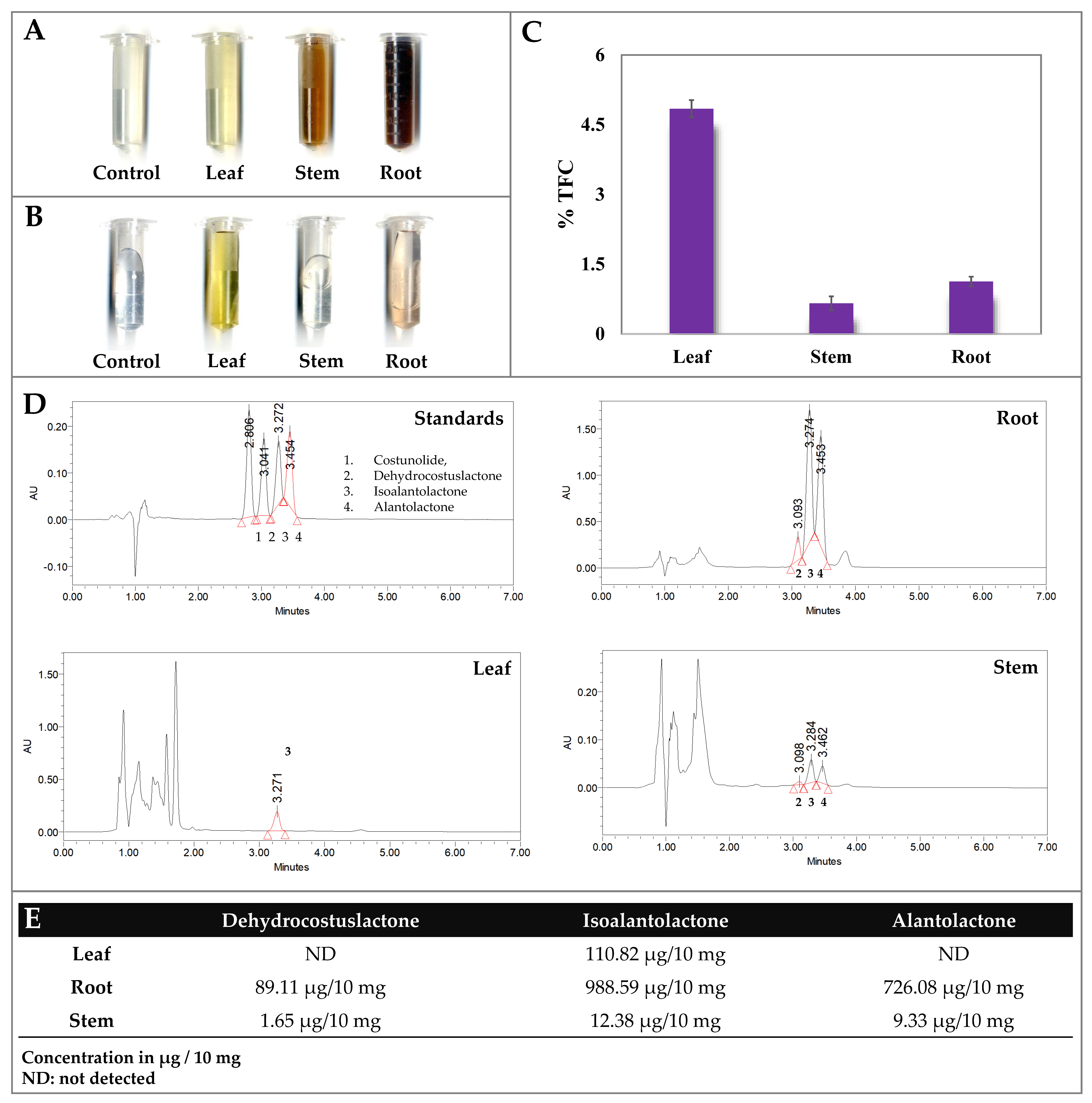

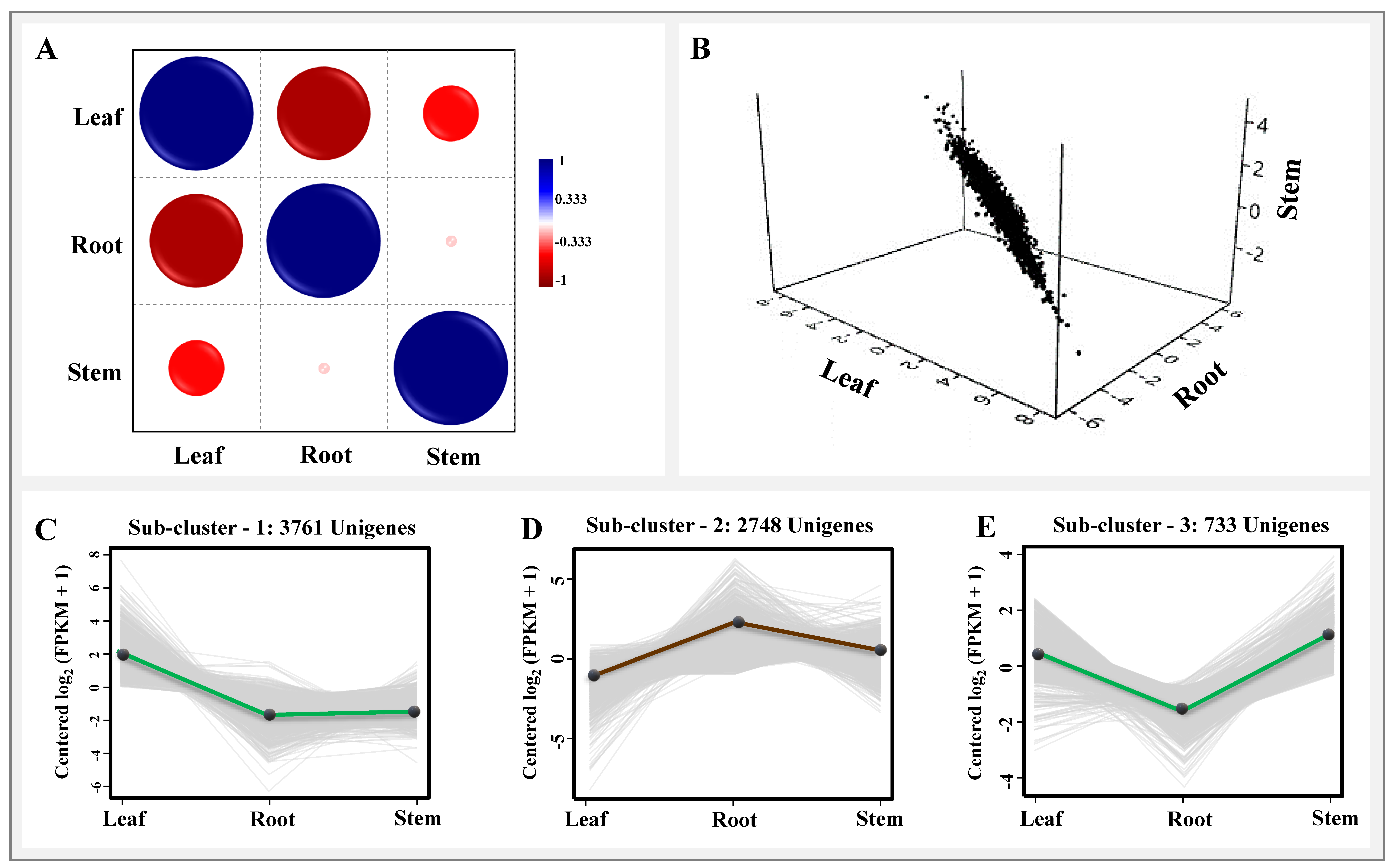
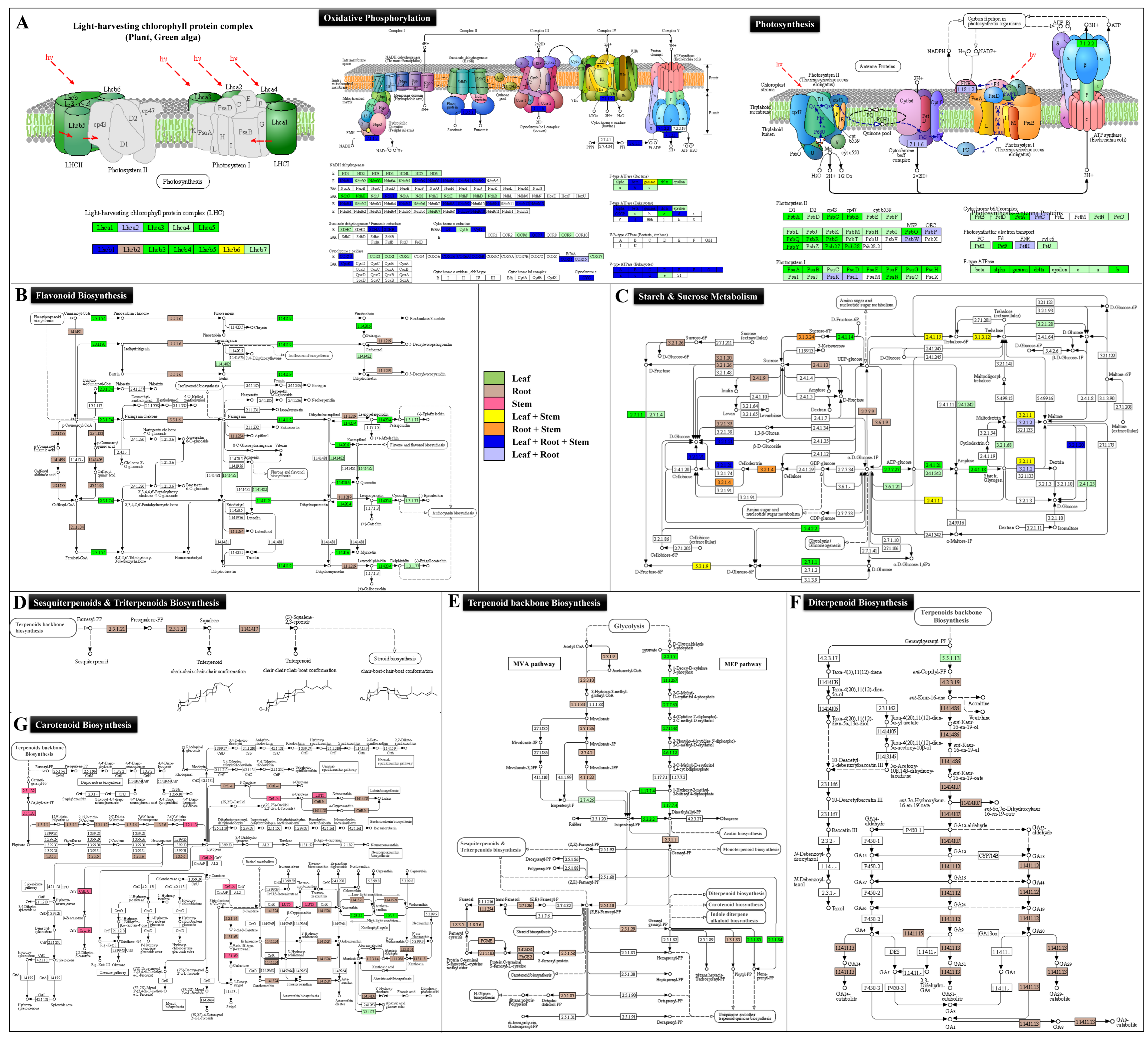
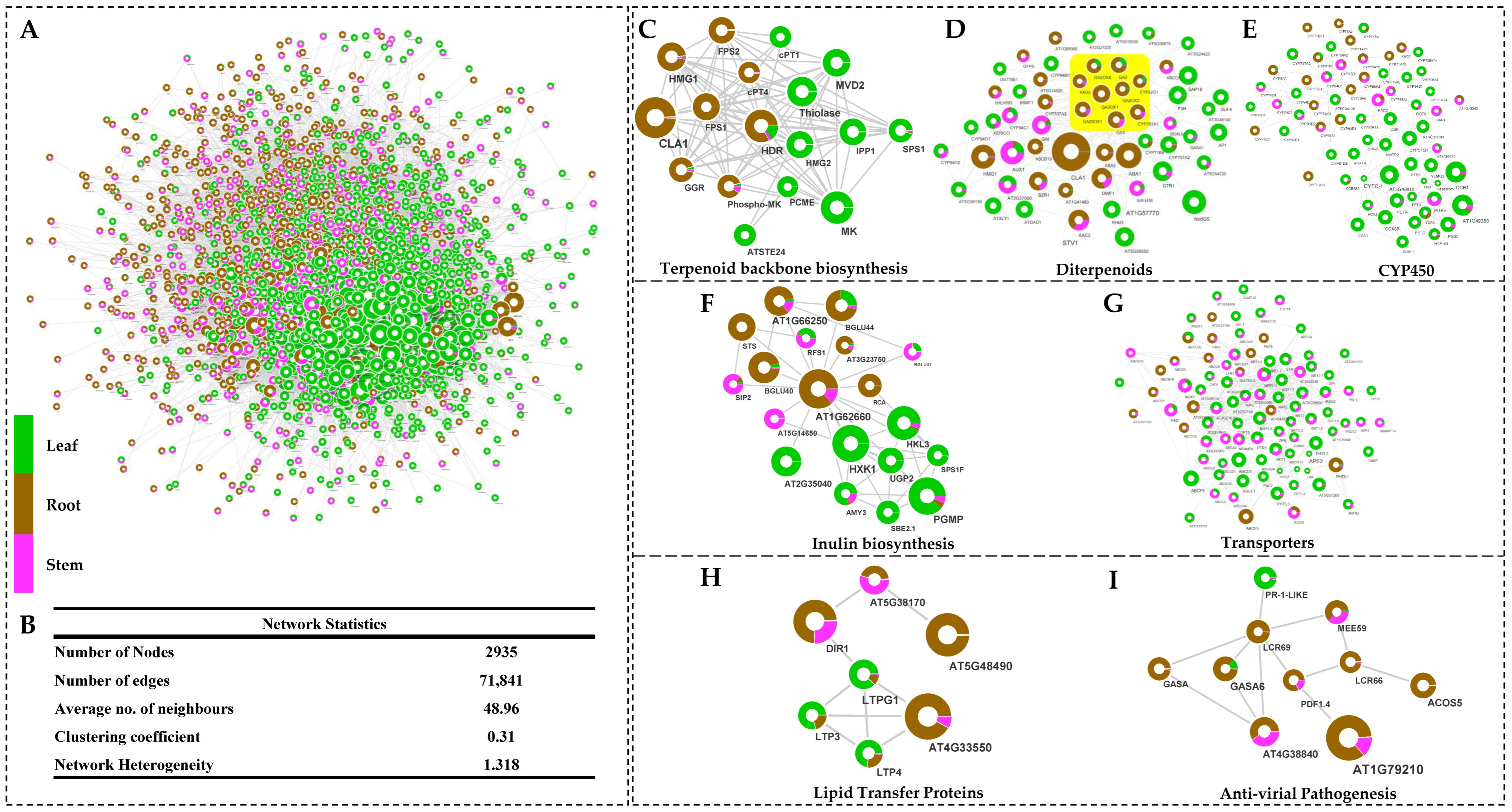
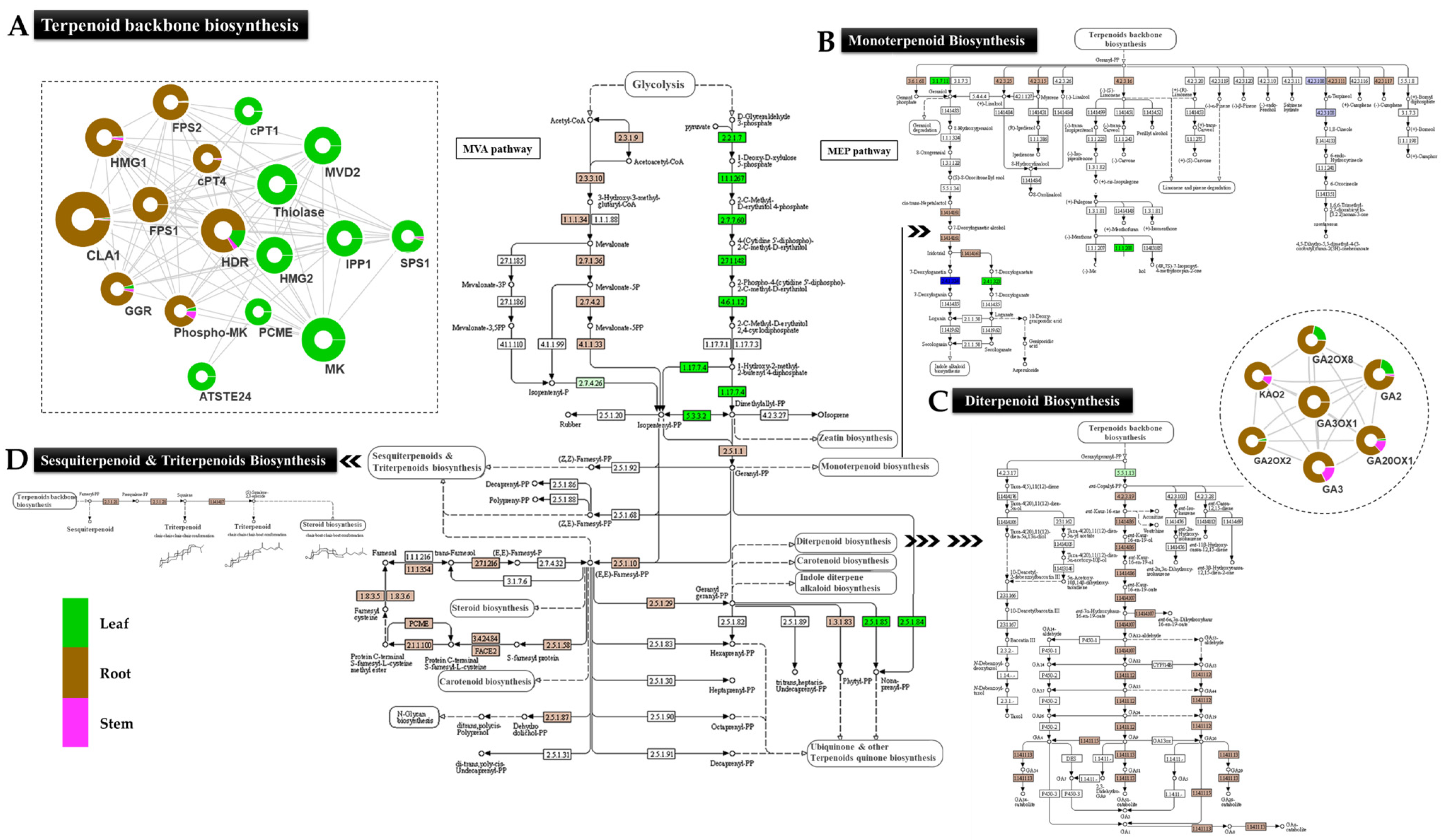
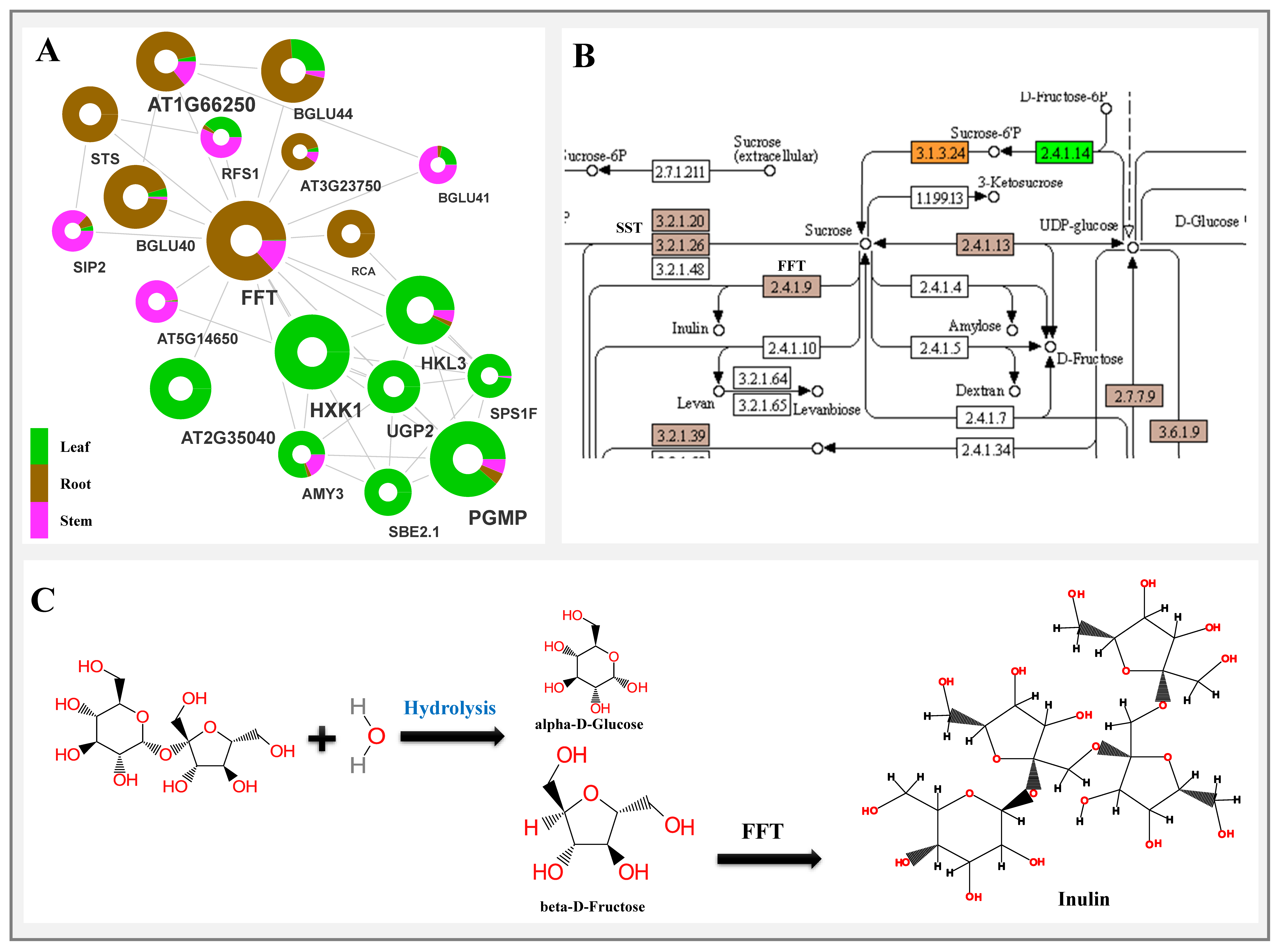
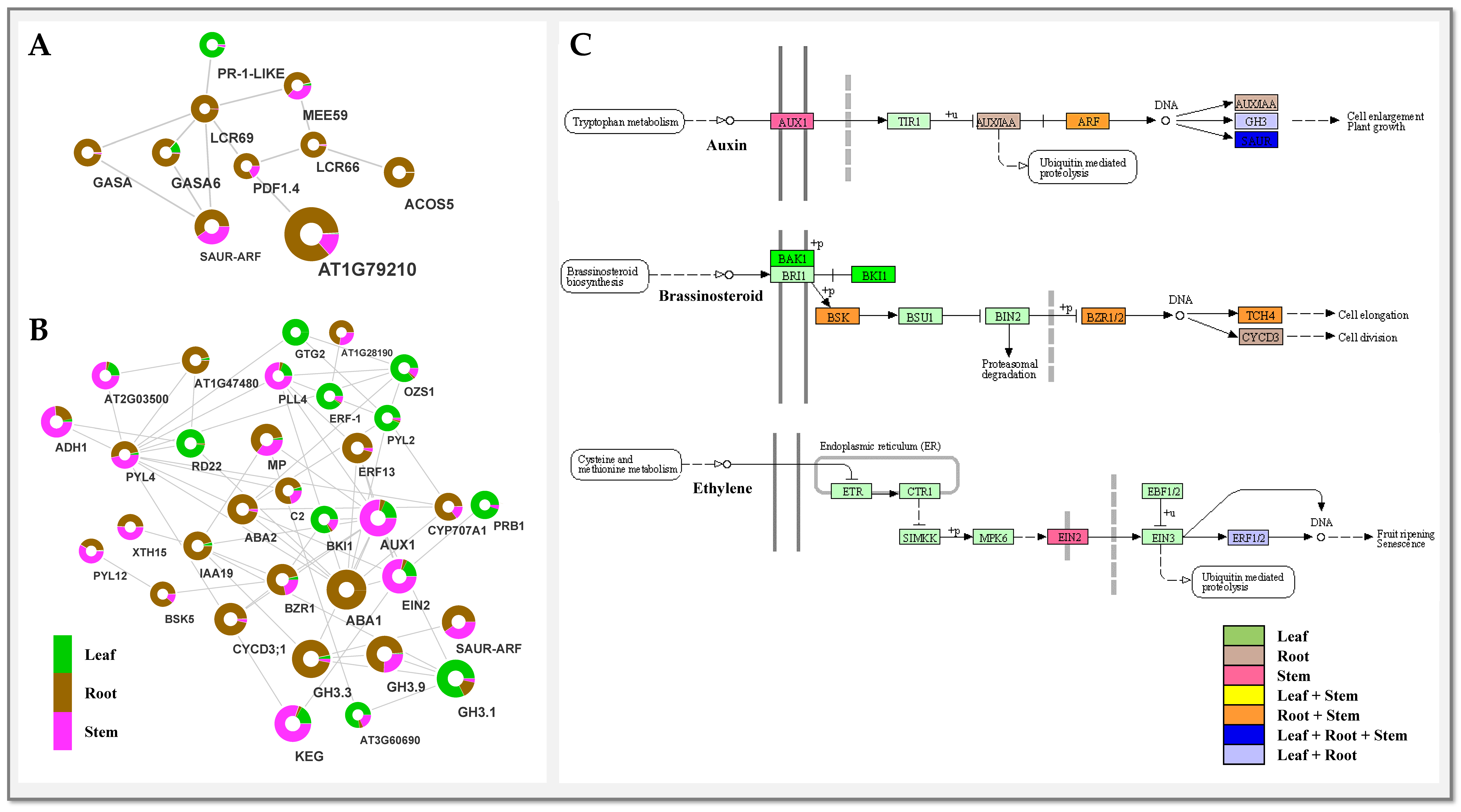
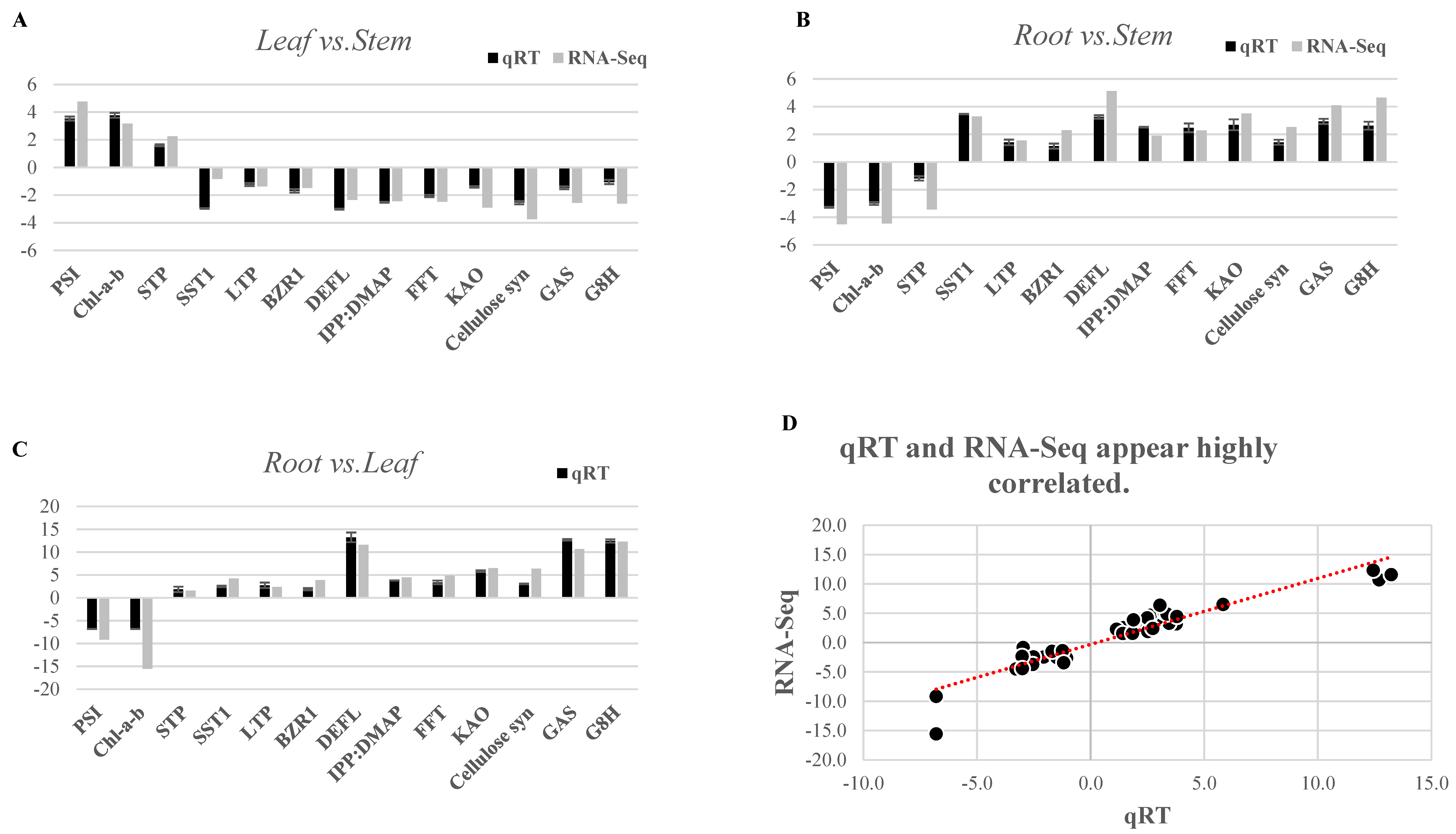

| S. No. | Phytochemical Test | Leaf | Stem | Root | |
|---|---|---|---|---|---|
| 1 | Saponins test | Foam test | + | − | − |
| Olive oil test | + | − | − | ||
| 2 | Salkowski’s test | Terpenoids estimation | + | ++ | +++ |
| 3 | Liebermann-Burchard test | Steroids | + | ++ | +++ |
| Triterpenoids | + | ++ | +++ | ||
| 4 | Alkaline reagent test | Total Flavonoids Content | +++ | − | ++ |
| Term-IDs | Description | Leaf | Root | Stem | p Value |
|---|---|---|---|---|---|
| map00906 | Carotenoid biosynthesis | 0.0 | 1.7 | 1.0 | 2.43 × 10−5 |
| map00904 | Diterpenoid biosynthesis | −1.2 | 3.2 | 0.0 | 3.06 × 10−7 |
| map00909 | Sesquiterpenoid and triterpenoid biosynthesis | 0.0 | 3.4 | 0.0 | 5.87 × 10−24 |
| map00941 | Flavonoid biosynthesis | 3.3 | 1.1 | −3.9 | 0.00035 |
| map00480 | Glutathione metabolism | 0.0 | −1.4 | 0.0 | 0.0046 |
| map00910 | Nitrogen metabolism | 1.5 | −2.8 | 0.0 | 0.00039 |
| map00190 | Oxidative phosphorylation | 1.4 | 1.1 | 1.5 | 1.67 × 10−5 |
| map03030 | DNA replication | −1.8 | 1.7 | 0.0 | 0.0192 |
| map00195 | Photosynthesis | 2.5 | −2.1 | −2.7 | 4.23 × 10−9 |
| map00196 | Photosynthesis—antenna proteins | 2.5 | −3.4 | 0.0 | 8.47 × 10−8 |
| map04141 | Protein processing in endoplasmic reticulum | 0.7 | 0.0 | −1.0 | 0.0432 |
| map03010 | Ribosome | 2.0 | −1.4 | −2.5 | 3.02 ×10−22 |
| KW-0927 | Auxin signaling pathway | −1.3 | 1.2 | 0.0 | 0.0107 |
| CL:23415 | Jasmonic acid signaling pathway | −3.1 | 3.2 | 0.0 | 0.0276 |
| KW-0618 | Plastoquinone | 3.1 | −2.5 | −3.6 | 0.0016 |
| CL:14945 | regulation of tocopherol synthesis | 3.2 | −3.5 | 0.0 | 0.0041 |
| CL:39814 | Pentose and glucuronate interconversions | −2.3 | 2.8 | 0.0 | 0.0114 |
Publisher’s Note: MDPI stays neutral with regard to jurisdictional claims in published maps and institutional affiliations. |
© 2022 by the authors. Licensee MDPI, Basel, Switzerland. This article is an open access article distributed under the terms and conditions of the Creative Commons Attribution (CC BY) license (https://creativecommons.org/licenses/by/4.0/).
Share and Cite
Seth, R.; Devi, A.; Sharma, B.; Masand, M.; Singh, G.; Pal, P.; Holkar, A.; Sharma, S.; Sharma, V.; Negi, S.; et al. An Integrative Transcriptional Network Revealed Spatial Molecular Interplay Underlying Alantolactone and Inulin Biosynthesis in Inula racemosa Hook f. Int. J. Mol. Sci. 2022, 23, 11213. https://doi.org/10.3390/ijms231911213
Seth R, Devi A, Sharma B, Masand M, Singh G, Pal P, Holkar A, Sharma S, Sharma V, Negi S, et al. An Integrative Transcriptional Network Revealed Spatial Molecular Interplay Underlying Alantolactone and Inulin Biosynthesis in Inula racemosa Hook f. International Journal of Molecular Sciences. 2022; 23(19):11213. https://doi.org/10.3390/ijms231911213
Chicago/Turabian StyleSeth, Romit, Amna Devi, Balraj Sharma, Mamta Masand, Gopal Singh, Poonam Pal, Ashlesha Holkar, Shikha Sharma, Vishal Sharma, Shivanti Negi, and et al. 2022. "An Integrative Transcriptional Network Revealed Spatial Molecular Interplay Underlying Alantolactone and Inulin Biosynthesis in Inula racemosa Hook f." International Journal of Molecular Sciences 23, no. 19: 11213. https://doi.org/10.3390/ijms231911213
APA StyleSeth, R., Devi, A., Sharma, B., Masand, M., Singh, G., Pal, P., Holkar, A., Sharma, S., Sharma, V., Negi, S., & Sharma, R. K. (2022). An Integrative Transcriptional Network Revealed Spatial Molecular Interplay Underlying Alantolactone and Inulin Biosynthesis in Inula racemosa Hook f. International Journal of Molecular Sciences, 23(19), 11213. https://doi.org/10.3390/ijms231911213









